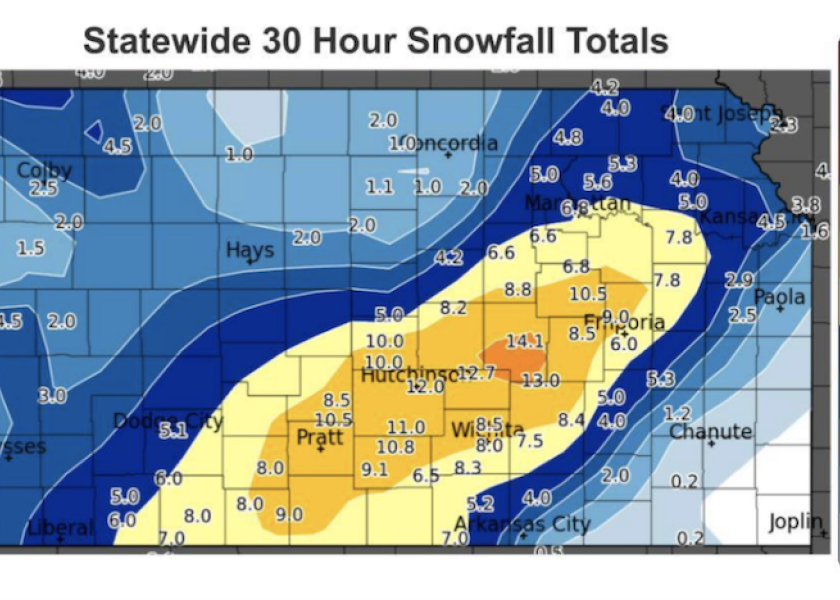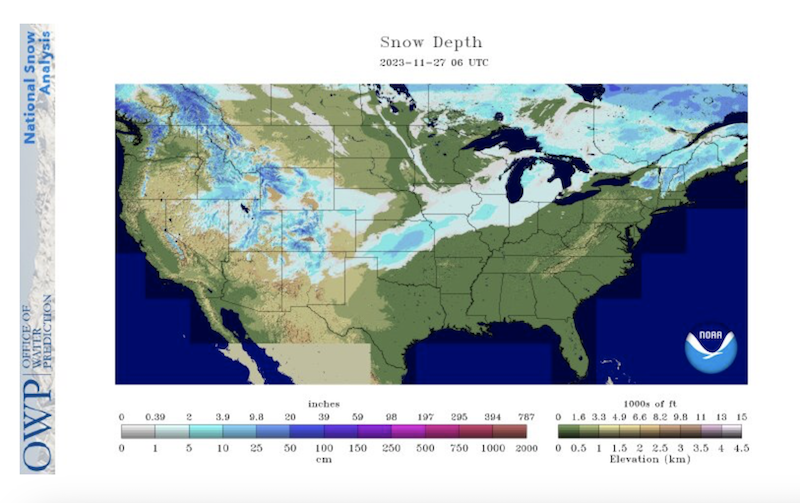Kansas Landed in the Bull's-Eye of a Late-November Snow, And It's Good News for Winter Wheat

A big November snowfall is providing hope for a winter wheat crop that’s off to a rough start again in the Great Plains. A dry fall helped harvest progress, but the stubborn drought situation also created poor conditions to help germinate the winter wheat crop this year. That was until a snow system brought much-needed moisture in the Great Plains, with the bull's-eye being central Kansas.
USDA meteorologist Brad Rippey describes the system as a fairly wet snow, with many locations seeing a 10:1 snow-water ratio. He says that compares to typical snow-water ratios in that part of the country. He says when it’s away from the oceans, the snow-water ratios are closer to 20:1.

The snow coverage peaked on November 27, with a NOAA map showing the track across the Midwest.
Snow totals varied, with the heaviest amounts falling east of Hutchinson, Kan. According to official snowfall totals, Hutchinson received 12 inches of snow, but a pocket to the east of the city received 14.1 inches of snow.

Rippey says snow in late November across the nation’s heartland isn’t rare, especially when it’s a narrow band. However, he says areas where the earlier heavy snow fell included the southern edge of the snow band, which went across northern Oklahoma and southern Kansas.
“Wichita’s snowiest November on record occurred way back in 1888, with 9.0 inches. Other big November snows in Wichita occurred in 1906 (8.7 inches), 1951 (8.1 inches), 1952 (6.8 inches), 1972 (7.1 inches), 1975 (5.5 inches), 1984 (6.8 inches), 1987 (6.2 inches) and 2006 (5.5 inches). The storm in 1952 occurred on the exact same date (6.8 inches fell on November 25, 1952),” says Rippey.
Winter wheat conditions in Kansas rated 16% very poor, 16% poor, 36% fair, 28% good, and 4% excellent. Winter wheat emerged was 93%, ahead of 86% last year, and near 90% for the five-year average. pic.twitter.com/kP2655jdae — KansasWheat (@KansasWheat) November 28, 2023
The snow was a welcome sight for growers who planted winter wheat. According to USDA, 93% of the winter wheat has emerged in Kansas, compared to 86% at this same time in 2022. The five-year average is 90%.
“Of course, the wet snow is great news for winter wheat, which in Kansas in particular has been struggling, with nearly one-third of the crop rated in very poor to poor condition,” Rippey adds. “However, as you can see from the snow map, the beneficial moisture largely bypassed the northern and southern Plains, as well as southeastern Colorado, northwestern Kansas and eastern Nebraska.”
Potential Impact on Drought
What does this mean for potential changes in the U.S. Drought Monitor? Rippey helps author the Drought Monitor. He says especially if a wetter-than-normal pattern continues, areas of the Great Plains still experiencing drought should see gradual improvement. This early snow is a good start.

While the pattern change is a good thing, it’s still a debate whether it can be attributed to El Niño.
“Sometimes, it’s hard to tell where the effects of El Niño start and end,” explains Rippey. “Over the past couple of weeks, we’ve certainly seen a stronger subtropical jet stream, which is likely attributable to El Niño. This new pattern has delivered drought relief in other areas, including the South, East and lower Midwest.”
Related News:
El Nino's Effect on Crop Prices
Harvest Update: Less than 5% of Corn Acres to Go







